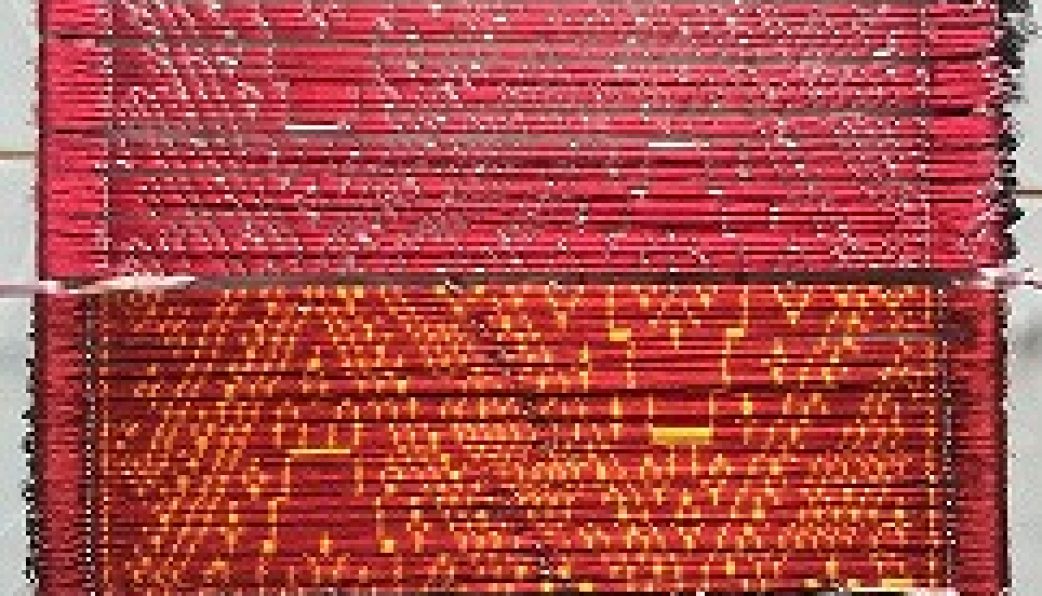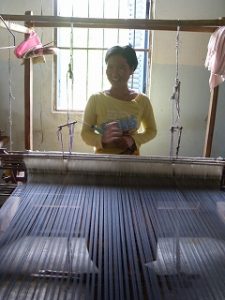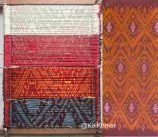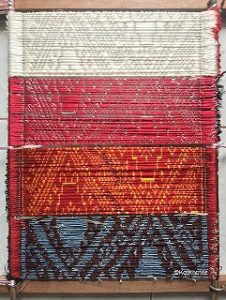 The old traditional weaving skills have been transferred from many generations to preserve the history of Cambodian hand-made weaving work. The weaving products showed the wonderful design, dyeing and weaving work of the patient weavers that have prepared all process of weaving work of warp and weft by hand to produce the complex and beautiful fabric with natural dyeing. Moreover, we are surprise to see their designs of ikat pattern that they have tied different patterns from small to pig patterns by combination of too many tied dots to become a whole pattern or image. It takes time and patience to tie and dye from one color to three colors in one pattern or a Kben (4m). They play an important role in showing Cambodian traditional textile “hand weaving”. We want to preserve and show the non-technology age that Khmer weavers have produced the wonderful fabric from cotton and silk yarn. They have used natural resource around their community to produce the yarn and colors. We really admire their complex work to produce the environmentally friendly products.
The old traditional weaving skills have been transferred from many generations to preserve the history of Cambodian hand-made weaving work. The weaving products showed the wonderful design, dyeing and weaving work of the patient weavers that have prepared all process of weaving work of warp and weft by hand to produce the complex and beautiful fabric with natural dyeing. Moreover, we are surprise to see their designs of ikat pattern that they have tied different patterns from small to pig patterns by combination of too many tied dots to become a whole pattern or image. It takes time and patience to tie and dye from one color to three colors in one pattern or a Kben (4m). They play an important role in showing Cambodian traditional textile “hand weaving”. We want to preserve and show the non-technology age that Khmer weavers have produced the wonderful fabric from cotton and silk yarn. They have used natural resource around their community to produce the yarn and colors. We really admire their complex work to produce the environmentally friendly products.
Kei Khmer Community would like to show the brief of the traditional hand weaving that Cambodian weavers used to produce Sampot Hol “ikat fabric”. This is the example of Pkar Chan design as below:
Pkar Chan Design Pattern on Silk Yarn
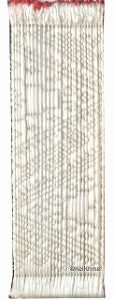 We would like to raise the sample of 33-bunch design “Pkar Chan” to show the process. Before we could start tying the pattern, we had to spin weft to tie the pattern. We spun 33 bunches for tying the pattern. We have to tie the both borders of bunches to fix all bunches and useful for us to tie in the middle pattern. Then we measured the sizes of each design in the whole space that we would tie in the frame in order to fit the whole size. We tied only haft pattern of this design because we would combine and repeat it in weaving process. Please look image:
We would like to raise the sample of 33-bunch design “Pkar Chan” to show the process. Before we could start tying the pattern, we had to spin weft to tie the pattern. We spun 33 bunches for tying the pattern. We have to tie the both borders of bunches to fix all bunches and useful for us to tie in the middle pattern. Then we measured the sizes of each design in the whole space that we would tie in the frame in order to fit the whole size. We tied only haft pattern of this design because we would combine and repeat it in weaving process. Please look image:
Dyeing First Traditional Color of Lac Khmer
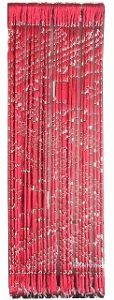 Normally, Lac Khmer is dyed in the first color because we can get pink or red. We put the tied pattern into the basin of boiled color that we boiled to get the red from Lac Khmer. We soaked and twisted the pattern to make the color absorbed well. After that we carried and hit it 30 times of both edges. We repeated hitting 5 to 8 times to make the pattern smooth and get the pattern well absorbed. They checked the pattern by cutting one or two tied dots to see the color inside. If they observed the middle tied dot showed the smooth color as outsider, they would completed dyeing and dry it to dye next color. If not, they continue to put in dye water and hit it to be smooth color.
Normally, Lac Khmer is dyed in the first color because we can get pink or red. We put the tied pattern into the basin of boiled color that we boiled to get the red from Lac Khmer. We soaked and twisted the pattern to make the color absorbed well. After that we carried and hit it 30 times of both edges. We repeated hitting 5 to 8 times to make the pattern smooth and get the pattern well absorbed. They checked the pattern by cutting one or two tied dots to see the color inside. If they observed the middle tied dot showed the smooth color as outsider, they would completed dyeing and dry it to dye next color. If not, they continue to put in dye water and hit it to be smooth color.
Dyeing Second Color from Tree Bark of Prohout
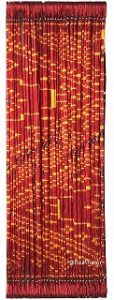 After we boiled tree bark to get yellow, we poured the color into a basin to soak the tied and dyed pattern. We soaked and twisted it as we did in Lac Khmer process. We hit and checked the color as before. When we cut and observed the color is well absorbed, we stopped and dried the tied pattern next dyeing process.
After we boiled tree bark to get yellow, we poured the color into a basin to soak the tied and dyed pattern. We soaked and twisted it as we did in Lac Khmer process. We hit and checked the color as before. When we cut and observed the color is well absorbed, we stopped and dried the tied pattern next dyeing process.
Dyeing Third color from Ebony Fruit
![]() This process is important take time to do it after the first designing pattern because we need to retie the colors that we want to keep and show in the whole pattern. We retied the red and yellow that we preferred the colors’ pattern and would dye other parts to become dark brown as the background color.
This process is important take time to do it after the first designing pattern because we need to retie the colors that we want to keep and show in the whole pattern. We retied the red and yellow that we preferred the colors’ pattern and would dye other parts to become dark brown as the background color.
Spinning the dyed yarns into the spools
After dyeing all colors and completed dried, we cut out all tied dots and spin into spools for weaving. We spin for first to 33 spools in order. We had to carefully spin into ordering spools. If we spin in the wrong order, we can’t weave to be the same as the tied pattern and are difficult to join the pattern or show the wrong pattern. If we spin from number one to 33, we have to weave from number one to 33 as well.
Weaving the spinning spools
We use number one spool to start weaving. We weave from number one to number 33. When we reach to the last number of 33, we had to turn back in order from 33 to 32, 31, 30, …. and 1. The haft pattern would become the whole pattern of Pkar Chan design. Weaving and designing ikat pattern connects each other to combine as the whole pattern.
If you have more ideas and comments, please send message to: info@keikhmer.org.
We will welcome your critical ideas to improve our work.

